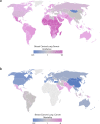Grass-roots entrepreneurship complements traditional top-down innovation in lung and breast cancer
- PMID: 35064182
- PMCID: PMC8782943
- DOI: 10.1038/s41746-021-00545-x
Grass-roots entrepreneurship complements traditional top-down innovation in lung and breast cancer
Abstract
The majority of biomedical research is funded by public, governmental, and philanthropic grants. These initiatives often shape the avenues and scope of research across disease areas. However, the prioritization of disease-specific funding is not always reflective of the health and social burden of each disease. We identify a prioritization disparity between lung and breast cancers, whereby lung cancer contributes to a substantially higher socioeconomic cost on society yet receives significantly less funding than breast cancer. Using search engine results and natural language processing (NLP) of Twitter tweets, we show that this disparity correlates with enhanced public awareness and positive sentiment for breast cancer. Interestingly, disease-specific venture activity does not correlate with funding or public opinion. We use outcomes from recent early-stage innovation events focused on lung cancer to highlight the complementary mechanism by which bottom-up "grass-roots" initiatives can identify and tackle under-prioritized conditions.
© 2022. The Author(s).
Conflict of interest statement
The authors declare no competing interests.
Figures






References
-
- Academic Research and Development. https://www.nsf.gov/statistics/2018/nsb20181/report/sections/academic-re... (National Science Foundation, 2018).
-
- Budget. https://www.nih.gov/about-nih/what-we-do/budget (2020).
LinkOut - more resources
Full Text Sources

